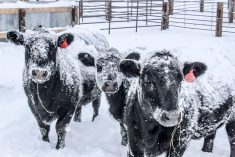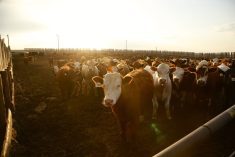Chicago | Reuters — Chicago Mercantile Exchange live cattle futures ended higher on Friday, with December helped by its discount to prices for market-ready or cash cattle, traders said.
December closed up 1.45 cents per pound at 166.8 cents, and February 1.825 cents higher at 168.375 cents (all figures US$).
On Friday, cash cattle in Kansas moved at $167 per hundredweight (cwt), down $1 from last week, feedlot sources said. Nebraska cash cattle sold at $167, $1 lower than on Thursday and a week ago, they said.
Slumping margins and lacklustre beef sales discouraged packers from spending more for cattle, traders and analysts said.
Read Also

Alberta crop conditions improve: report
Varied precipitation and warm temperatures were generally beneficial for crop development across Alberta during the week ended July 8, according to the latest provincial crop report released July 11.
Friday morning’s choice wholesale beef price dropped $1.36/cwt from Thursday to $249.16. Select climbed $1.19 to $238.44, the U.S. Department of Agriculture said.
Beef packer margins for Friday were a negative $109.70 per head, compared with a negative $106.05 on Thursday and a negative $102.05 a week earlier, according to Colorado-based analytics firm HedgersEdge.com.
Fund buying and buy stops accelerated live cattle futures advances.
Funds trading in CME’s live cattle and hog markets periodically sold, or rolled, December long positions and bought deferred months in a procedure known as the Standard + Poor’s Goldman Sachs Commodity Index (S+PGSCI) “roll.”
Friday was the first of five days for the S+PGSCI roll process.
Next week, investors will monitor forecasts for potentially early wintry weather in the Plains that might disrupt livestock production in the region.
CME feeder cattle drew support from fund buying, live cattle market gains and soft corn prices.
November closed two cents/lb. higher at 238.525 cents, and January at 232.45 cents, up 1.875 cents.
Hogs close higher
CME lean hogs climbed on short-covering in anticipation of a potential cash price rebound soon, traders said.
December ended up 1.125 cents/lb. at 88.775 cents, and February 1.425 cents higher at 88.425 cents.
USDA’s Friday morning direct cash hog prices were unavailable. Hogs in the Midwest traded mostly steady, according to regional hog dealers.
Cash prices tend to strengthen beginning around mid-to-late November as colder weather causes hogs to gain weight more slowly, said Doane Advisory Services economist Dan Vaught.
Ham demand picks up for Thanksgiving and Christmas, but tapers off soon afterwards, he added.
Government data showed the morning’s wholesale pork price, or cutout, down $1.44 per cwt from Thursday at $93.86, led by a $6.43/cwt drop in ham costs.
Fund buying developed after the December contract broke through the 10-day moving average of 88.34 cents.
February moved beyond the 10- and 20-day moving averages of 87.94 and 88.17 cents, which triggered more fund purchases.
— Theopolis Waters reports on livestock futures markets for Reuters from Chicago.













